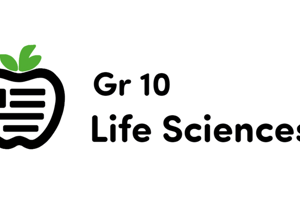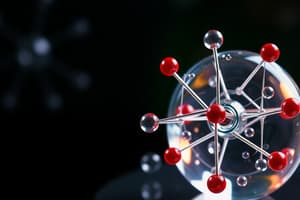Podcast
Questions and Answers
What is the basic unit of matter called?
What is the basic unit of matter called?
atom
Describe the nucleus of an atom.
Describe the nucleus of an atom.
center of an atom, made of protons and neutrons
What are protons?
What are protons?
positive charge and found in the nucleus
What are neutrons?
What are neutrons?
What are electrons?
What are electrons?
Why are atoms neutral despite having charged particles?
Why are atoms neutral despite having charged particles?
What is a chemical element?
What is a chemical element?
What does an element's atomic number represent?
What does an element's atomic number represent?
Atoms of the same element that differ in the number of neutrons are known as?
Atoms of the same element that differ in the number of neutrons are known as?
How are isotopes identified?
How are isotopes identified?
Why do all isotopes of an element have the same chemical properties?
Why do all isotopes of an element have the same chemical properties?
What is a chemical compound?
What is a chemical compound?
What holds atoms in a compound together?
What holds atoms in a compound together?
What is a covalent bond?
What is a covalent bond?
What is an ionic bond?
What is an ionic bond?
What is an ion?
What is an ion?
An atom that loses electrons has a negative charge.
An atom that loses electrons has a negative charge.
What is the structure that results when atoms are joined together by covalent bonds called?
What is the structure that results when atoms are joined together by covalent bonds called?
True or false: In a water molecule, each hydrogen atom forms a single covalent bond.
True or false: In a water molecule, each hydrogen atom forms a single covalent bond.
What are the slight attractions that develop between oppositely charged regions of nearby molecules called?
What are the slight attractions that develop between oppositely charged regions of nearby molecules called?
A water molecule is neutral.
A water molecule is neutral.
Why is a water molecule polar?
Why is a water molecule polar?
True or false: The attractions between the hydrogen atom on one water molecule and the oxygen atoms on another water molecule is an example of hydrogen bonds.
True or false: The attractions between the hydrogen atom on one water molecule and the oxygen atoms on another water molecule is an example of hydrogen bonds.
What is cohesion?
What is cohesion?
What is adhesion?
What is adhesion?
What is a mixture?
What is a mixture?
A mixture of two or more substances in which the molecules of the substances are evenly mixed is called a?
A mixture of two or more substances in which the molecules of the substances are evenly mixed is called a?
What is the greatest solvent in the world?
What is the greatest solvent in the world?
What is suspension?
What is suspension?
What is a solute?
What is a solute?
What is a solvent?
What is a solvent?
Why is water neutral despite the production of hydrogen ions and hydroxide ions?
Why is water neutral despite the production of hydrogen ions and hydroxide ions?
What does the pH scale indicate?
What does the pH scale indicate?
How many more H+ ions does a solution with a pH of 4 have than a solution with a pH of 5?
How many more H+ ions does a solution with a pH of 4 have than a solution with a pH of 5?
What is an acid?
What is an acid?
Strong bases have pH values ranging from 11-14.
Strong bases have pH values ranging from 11-14.
What are buffers?
What are buffers?
How many valence electrons does each carbon atom have?
How many valence electrons does each carbon atom have?
What gives carbon the ability to form chains that are almost unlimited in length?
What gives carbon the ability to form chains that are almost unlimited in length?
Many of the molecules in living cells are so large that they are known as?
Many of the molecules in living cells are so large that they are known as?
What is the process called by which macromolecules are formed?
What is the process called by which macromolecules are formed?
When monomers join together, what do they form?
When monomers join together, what do they form?
What are the 4 groups of organic compounds found in living things?
What are the 4 groups of organic compounds found in living things?
What atoms make up carbohydrates?
What atoms make up carbohydrates?
Simple sugar molecules are also called?
Simple sugar molecules are also called?
What are monosaccharides?
What are monosaccharides?
What are polysaccharides?
What are polysaccharides?
How do plants and animals store excess sugar?
How do plants and animals store excess sugar?
What kinds of atoms are lipids mostly made of?
What kinds of atoms are lipids mostly made of?
What are 3 common categories of lipids?
What are 3 common categories of lipids?
Many lipids are formed when glycerol molecules combine with compounds called?
Many lipids are formed when glycerol molecules combine with compounds called?
What does saturated mean in relation to lipids?
What does saturated mean in relation to lipids?
What does unsaturated mean in relation to lipids?
What does unsaturated mean in relation to lipids?
What does polyunsaturated mean in relation to lipids?
What does polyunsaturated mean in relation to lipids?
What kind of atoms do nucleic acids contain?
What kind of atoms do nucleic acids contain?
The monomers that make up nucleic acids are known as?
The monomers that make up nucleic acids are known as?
A nucleotide consists of what 3 parts?
A nucleotide consists of what 3 parts?
What is a function of nucleic acids in living things?
What is a function of nucleic acids in living things?
What are the 2 kinds of nucleic acids?
What are the 2 kinds of nucleic acids?
Proteins contain which kinds of atoms?
Proteins contain which kinds of atoms?
Proteins are polymers of molecules called?
Proteins are polymers of molecules called?
What are 4 roles that proteins play in living things?
What are 4 roles that proteins play in living things?
What is a chemical reaction?
What is a chemical reaction?
What are reactants?
What are reactants?
What are products?
What are products?
Chemical reactions always involve changes in chemical?
Chemical reactions always involve changes in chemical?
What is released or absorbed whenever chemical bonds form or are broken?
What is released or absorbed whenever chemical bonds form or are broken?
What do chemical reactions that absorb energy need to occur?
What do chemical reactions that absorb energy need to occur?
Chemists call the energy needed to get a reaction started the?
Chemists call the energy needed to get a reaction started the?
What is a catalyst?
What is a catalyst?
Proteins that act as biological catalysts are called?
Proteins that act as biological catalysts are called?
What do enzymes do?
What do enzymes do?
The reactants of enzyme-catalyzed reactions are known as?
The reactants of enzyme-catalyzed reactions are known as?
Why are the active site and the substrates in an enzyme-catalyzed reaction compared to a lock and key?
Why are the active site and the substrates in an enzyme-catalyzed reaction compared to a lock and key?
The binding together of an enzyme and a substrate forms a?
The binding together of an enzyme and a substrate forms a?
How do most cells regulate the activity of enzymes?
How do most cells regulate the activity of enzymes?
Study Notes
Basic Units of Matter
- The smallest unit of matter is called an atom.
- Atoms consist of a nucleus containing protons (positive charge) and neutrons (neutral charge).
- Electrons with a negative charge orbit around the nucleus.
Atomic Structure and Properties
- Atoms remain neutral when the number of protons equals the number of electrons.
- An element is defined as a pure substance made of only one type of atom.
- An element's atomic number indicates the number of protons it has.
- Isotopes are variants of the same element with differing neutron counts, identified by their mass number.
- All isotopes of an element exhibit similar chemical properties due to identical electron and proton counts.
Chemical Compounds and Bonds
- A chemical compound forms when atoms of different elements chemically combine.
- Atoms in a compound are held together by chemical bonds:
- Covalent bonds involve sharing electrons.
- Ionic bonds occur when electrons are transferred between atoms.
Ions and Molecules
- An ion is an atom that has gained or lost electrons, resulting in a charge.
- A molecule is created when atoms are bonded through covalent means.
Water and Its Properties
- Water molecules are neutral overall despite the presence of charged hydrogen and hydroxide ions due to equal positive and negative charges.
- A water molecule is considered polar due to the unequal sharing of electrons, leading to an electrical charge distribution.
- Hydrogen bonds form due to attractions between hydrogen atoms of one water molecule and oxygen atoms of another.
Mixtures and Solutions
- A mixture consists of substances that are not chemically combined, leading to various types:
- Solutions are uniform mixtures of two or more substances.
- Suspensions contain particles that settle out, forming a heterogeneous mixture.
- Water is identified as the greatest solvent due to its ability to dissolve numerous substances.
Acids, Bases, and pH
- The pH scale measures how acidic or basic a solution is, with lower values being more acidic.
- An acid produces H+ ions in solutions, while buffers help maintain pH by reacting with strong acids or bases.
Organic Compounds and Macromolecules
- Carbon atoms possess four valence electrons, allowing for diverse bonding and creating extended chains.
- Macromolecules are large molecules formed through polymerization, where smaller units called monomers join to form polymers.
- Four primary groups of organic compounds: carbohydrates, proteins, lipids, and nucleic acids.
Carbohydrates, Lipids, Nucleic Acids, and Proteins
- Carbohydrates are composed of carbon (C), hydrogen (H), and oxygen (O); simple sugars are called monosaccharides.
- Lipids mainly consist of C, H, and O, classified into fats, oils, and waxes.
- Nucleic acids include DNA and RNA, built from nucleotides which consist of a sugar, phosphate, and nitrogen base.
- Proteins are polymers formed from amino acids, playing roles in structure, muscle contraction, and oxygen transport.
Chemical Reactions
- A chemical reaction transforms one set of chemicals into another, involving changes in chemical bonds.
- Reactants are starting materials, while products are formed substances after the reaction.
- Chemical reactions can absorb or release energy, with activation energy being necessary to initiate reactions.
Enzymes and Catalysis
- Catalysts accelerate chemical reactions, while enzymes are biological catalysts that enhance reaction rates in cells.
- Enzyme-substrate interactions are highly specific, often described as a lock and key mechanism based on precise fits.
- The combination of an enzyme and a substrate forms an enzyme-substrate complex, facilitating the conversion of substrates into products.
Studying That Suits You
Use AI to generate personalized quizzes and flashcards to suit your learning preferences.
Description
Test your knowledge on the basics of biology with these flashcards focused on Chapter 2: The Chemistry of Life. You'll cover essential concepts such as atoms, protons, neutrons, and electrons. Perfect for students wanting a quick review before exams.




